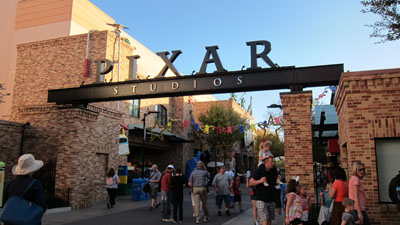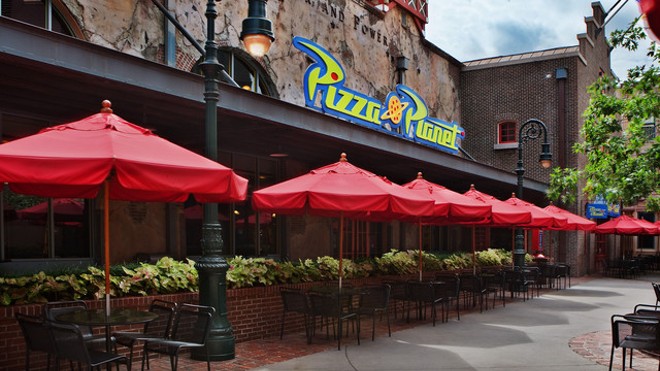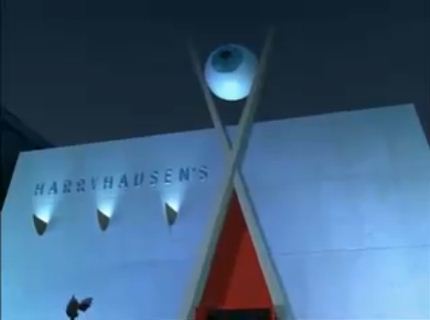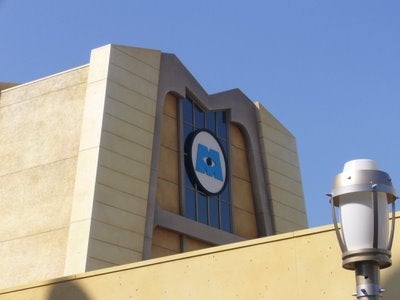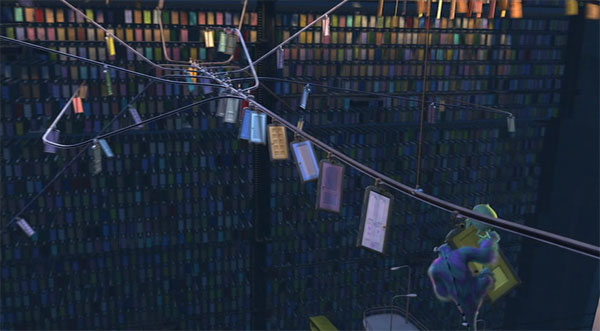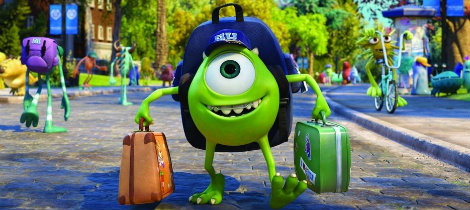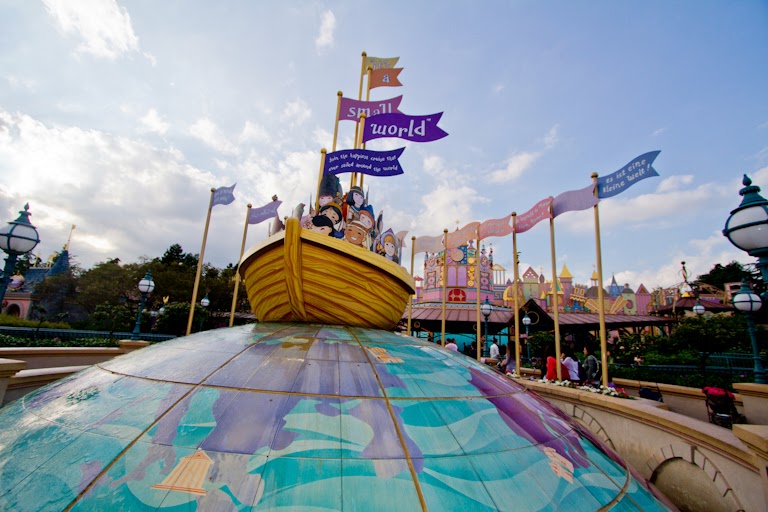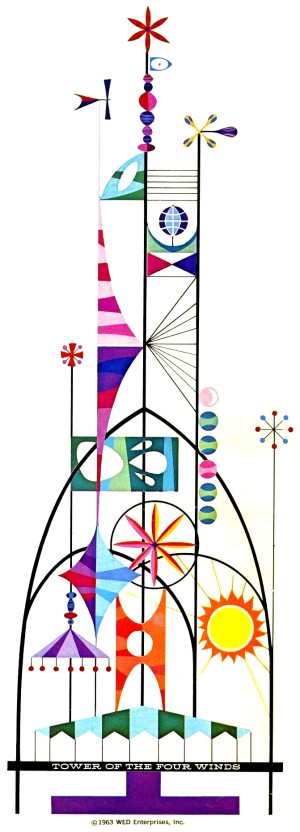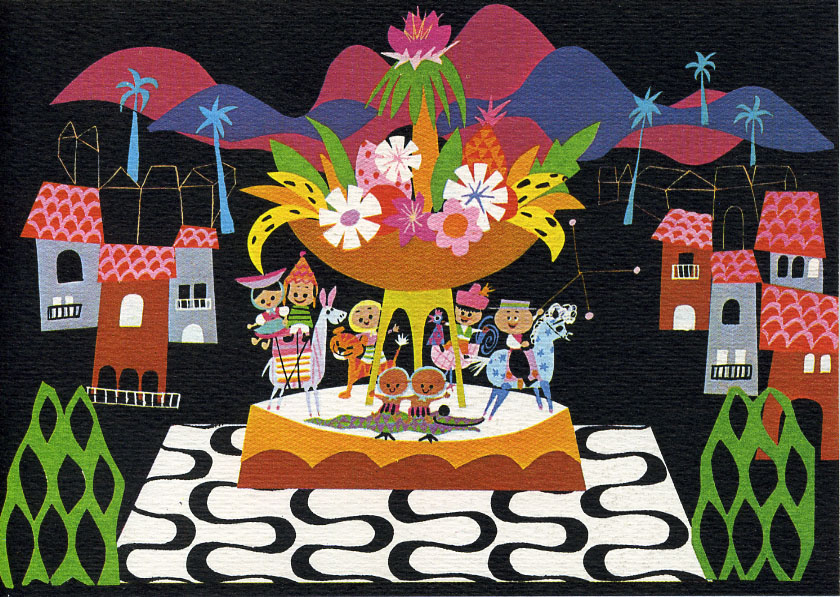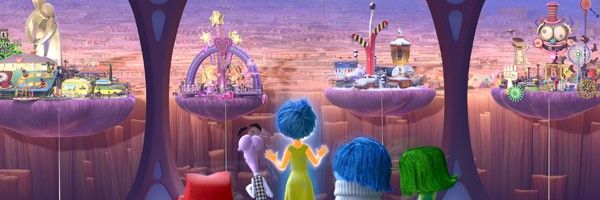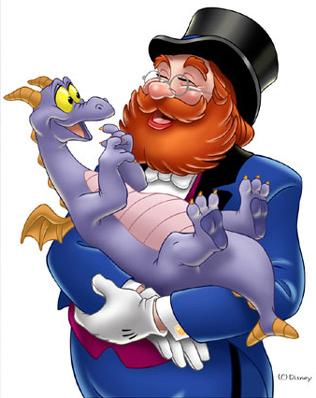Now, I don't want to seem lazy, but DLA's version of "it's a small world" (in my park it will have capitalized letters in the title) is a near-direct lift of the Hong Kong Disneyland version of the attraction as well as the World's Fair/Disneyland original. As usual, elements of my own imagination are incorporated, but because DLA's version is so similar to the two, I've decided that rather than a detailed ride-through, I'm going to do a list of what's different and what stays the same. So first, if you will, watch these wonderful videos of the versions in question.
_______________________________________
It's a Small World
The Exterior:
- Unlike existing versions of the attraction, DLA's It's a Small World has a unique facade, whereas the colors are "cool" shades of blue, green, and purple rather than the normal pastel-coloring of white, pink, yellow, and so on so forth. Additionally, several landmarks not seen in the "skyline" of existing Small World facades make their debut appearances here, including the Golden Gate Bridge, Sydney Opera House, the Statue of Liberty, and Mt. Everest. Other landmarks include the Leaning Tower of Pisa, the Eiffel Tower, a Japanese pagoda, Big Ben, a Dutch windmill, and several other "Small World staples."
- Like the Hong Kong version, guests enter and exit the attraction through a door in the base of the facade. Rather than entering beneath a Chinese-inspired pagoda, DLA guests enter beneath the aforementioned recreation of Sydney Opera House. An exterior overflow queue is featured but hardly used, as per Small World being a massive people-eating attraction.
- Every fifteen minutes, the typical Small World clock parade goes off with joyous music, quirky sound effects, and a parade of "dancing" dolls representing the various nations of the world. All of the original Disneyland dolls are featured in addition to Hong Kong's Chinese opera singer, and a new doll representing Australia. The boy, dressed in garbs similar to Crocodile Dundee, grabs ahold of a miniature crocodile, a tribute to Australia's bountiful wildlife.
- Also like Hong Kong, the large hole in the earth surrounding the forefront of the facade (where the boats would load and unload if this were Disneyland) is filled with colorful flowerbeds and shaped topiaries, a simple treat for those who take the time to look below.
The Interior Queue:
- Like Hong Kong, the interior queue is filled with the music of the 1964 original as well as hand-painted imagery of the Mary Blair-style. Unlike Hong Kong which features mere paintings of the already-seen facade, DLA's interior queue features Mary Blair-inspired paintings of the children of the world, international wildlife, and landmarks, similar to these:

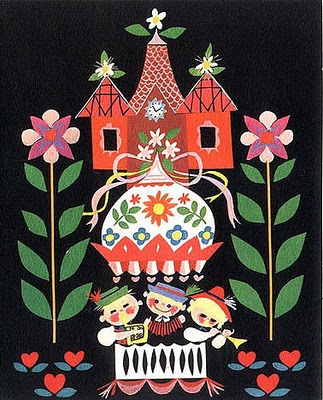
Of course, many of these murals are later realized in three-dimensional set pieces, but that doesn't matter, if anything, these are sneak peeks towards the adventures to come. After a solid couple of minutes meandering through mural-surrounded switchbacks, the queue opens into a larger room similar to the Disney World attraction; popcorn light-embroidered archways and formations similar to the facade line the walls, leading guests on a downward slope towards the loading and unloading docks.
- As an added detail, shields representing the flags of various nations (i.e. Australia, Germany, Italy, etc.) are placed on the railings separating each row prior to boarding, a feature currently unique to DLA.
The Hello Room:
- Unlike any version of the attraction, DLA's begins in a brand-new Hello Room inspired by a location that is truly out-of-this-world: Outer Space. Fiber optic stars and the decidedly less-convincing glow-in-the-dark star stickers create a Peter Pan's Flight-like representation of our solar system. As the music grows louder and louder (sung in English), 2D cutouts of the children of the world begin making intergalactic appearances dressed as astronauts and "flying past" in rockets. Some of these rockets read "Hello" in their child's respective language, so expect to see "Aloha," "Hola," "Hallo," "Bonjour," etc. Rotating planets and shooting stars occasionally fly past, leading the canal toward the room's major feature, a 2D cutout of Earth with a massive hole in its side, the appropriate entrance to the main attraction. From above the planet, a one-eyed martian figure sits in its UFO, waving at guests as they "crash land" on Earth.
The Arctic:
- As with Hong Kong, each show scene is introduced by a flower-like plaque labeling the approaching scene in multiple languages. In the case of DLA, each plaque starts with the English name of the country/continent, then the Maori name, Cantonese name, Japanese name, etc. Even if Australia is a primarily English-speaking continent, the point of It's a Small World is to apply a universal message of peace and love, making everyone feel welcome no matter what their country of origin.
- DLA's Arctic scene is nearly identical to Hong Kong's, right down to ice-skating Bambi and Thumper, the first of the Disney character cameos. One major difference is featured, this being the snowflakes are replaced by a miniature recreation of the Aurora Borealis.
Europe:
- Like Hong Kong and Disneyland, Europe is the first major show scene to follow the Arctic. DLA's Europe is laid out almost the exact same way as Hong Kong's (with some notable changes), starting with toy soldiers guarding the gates of Tivoli Gardens and the children of Scandinavia on the opposite side of the canal. Added to Scandinavia are a pair of ice-skating children, more reindeer rocking their heads back and forth from the mountaintops, and a new scene unique to DLA: Norway. Norway, represented through ice-capped mountains, Viking children singing aboard a smiling-dragon-headed ship, and Arendelle's castle. The next three Disney cameos are found in Norway: Anna, Elsa, and Olaf. Non-Frozen trolls appear near the side of the canal playing "peek-a-boo." Unlike Hong Kong and Disneyland, the themes of the Disney characters are removed from the soundtrack, making "it's a small world" the consistent theme.
- Marie, Cinderella, and Prince Charming are not found in the France sequence. Instead, Belle and the Beast are featured outside the Beast's castle, waving to boats as they pass. Back on the adjacent side of the canal, Alice and the White Rabbit stand near the spinning chess pieces. Two boys waving flags cheering on their favorite football team sit atop London Bridge, while a double-decker bus filled with miniature children crosses said bridge. Peter Pan and Tinkerbell fly in circles around the smiling crescent moon, joined by Wendy who sits atop the moon.
- Spain continues to be represented by a puppet show of Don Quixote and Sancho Panza, as well as some traditional Spanish dancers and windmills. Scotland is expanded, featuring the color-changing mountain as well as a giant representation of the Loch Ness Monster rocking back and forth, a rowboat with a child in it sitting on his snout. Italy remains the same, Pinocchio and all, as does Ireland. Notably, Punch and Judy have been added to Italy, shortly before we see Pinocchio and Jiminy Cricket.
- Switzerland, Denmark, and the Netherlands also remain the same as their Hong Kong counterparts, but now pave the forefront for some additional scene-work that expands the Europe sequence. Greece is quietly relocated to the position after the Netherlands on the right-hand side of the canal, featuring pegasus horses flying overhead (a la the hot-air balloons and tightrope walkers seen earlier in the ride), Mount Olympus, a pan flute-playing shepherd and his flock, a Grecian temple, and Hercules and Megara. A silly cyclops stands in the background, holding another boy playing the pan-flute in his hand. Bacchus appears in child form, clutching a goblet and singing from atop his dopey-faced unicorn.
- Also included is Germany, similar to the Disneyland Paris version of the scene. A Bavarian-style house with a clock tower appears on the left-hand side of the canal, fronted by a toy train and a giant wiener dog mixed with a slinky (think Toy Story's Slinky, but not actually Slinky). German children playing a tuba, French horn, and trumpet, a la Oktoberfest stand nearby in lederhosen, while other children partake in several of Germany's delicacies; pretzels, sausages, etc. Rapunzel's tower appears in the not-so-distant background, Rapunzel herself peering out from within.
- Russia is the final portion of the massive Europe scene, naturally featuring Moscow's St. Basil's Cathedral on an overhead ledge, fronted by dancing Cossack dancers.
Asia:
- Unlike Hong Kong, the next sequence is Asia, the second-largest room in the entire ride. DLA's Asia sequence is exactly the same as Hong Kong's with only a few key differences. Bagheera now joins Baloo and Mowgli, rocking his head back and forth; Shanghai's skyline replaces Hong Kong's skyline; that's literally it.
Africa & the Middle East:
- Similar to Disneyland, Africa and the Middle East are combined into one room, starting with the Middle East and ending with the jungles of Africa. Taking a cue from Hong Kong, the Middle Eastern segment is a near-exact replica of the Hong Kong scene with a few minor exceptions; a googly-eyed serpent coils around Cleopatra's den; Abu pops in and out of Genie's lamp rather than from beneath the bunting; the camel is pink like he is at Disneyland; the turban-wearing boy atop the camel is moved to the right-hand side of the canal, immediately following Cleopatra. The sphinx and Pyramids of Giza are also relocated near the camel-boy. This is for the purpose of eliminating the need for scene work on the left-hand side of the canal, as well as to create a seamless transition between the desert and jungle as they are now in the same room.
- Africa remains as it appears in Hong Kong, complete with Mufasa, Simba, Timon, and Pumbaa overlooking the entirety of the scene. As expected, some minor differences are implemented, mostly in the aesthetic regard. The zebra is now blue and pink-striped; the male lion with a flutist on his head from the Disneyland version is placed near the trio of singing children, the lion itself is orange and yellow; the tribal drums are taken out in favor of the jazz music heard in the 1964-1965 version.
The Americas:
- Also like Hong Kong, Latin America and North America are combined into one massive show-room. For the most part, Latin America is generally the same as the Hong Kong scene, with a few changes here and there. To start, the infamous rainforest scene with its kooky-eyed crocodile, heart-spotted jaguar and multitude of bizarre birds are "brought home" to the Latin America scene, appropriately placed on either side of the canal as the boats drift into the room from Africa, a perfect "jungle-y" transition. The crocodile appears on the left-hand side, shaking his head as if saying "no." The jaguar appears on the right-hand side, shaking his head as if saying "yes." Regardless, each animal holds an umbrella, protecting themselves from the never-ending downpour on either side of the canal. As the rainwaters part, the scene is generally the same as Hong Kong and Disneyland, with the Andes on the left-hand side and the penguins of South America on the right-hand side. Several key changes are implemented, such as Incan ruins placed before the Andes scene, featuring children in ceremonial garbs; a bipedal yellow-bird is placed near the cow and horse in front of the Andes; a Brazilian marketplace with pinatas, toys in birdcages, and other oddities (similar to Disneyland) is placed in between Rio and the penguins; the Three Caballeros are placed closer to the water's edge.
- North America starts out in a manner similar to Hong Kong, featuring a Canadian mountie and totem poles to the left and a rugged Southwestern desert to the right. Like Hong Kong, Woody, Jessie, and Bullseye appear amid the coyotes and cacti of the desert whilst Pocahontas and Meeko appear atop the snow-capped mountains to the left, all joining in the song. Newly added to the desert area is the typical saloon, hotel, and bank of a stereotypical western town, complete with a Native American chief pounding on a drum, some Native American girls dancing with him, cancan dancers on top of the saloon, cacti in cowboy clothing rocking back and forth, and a quartet of kachina dolls prominently standing in place. Newly added to the Canadian area is an ice-skating rink where children play hockey, a couple of head-rocking moose, and that's about it.
- However, once the boats pass beneath the Golden Gate Bridge, an entirely expanded North America scene awaits. The trip starts in the colorful bayous of the South past Brer Rabbit, Brer Fox, and Brer Bear, as well as some alligators and bullfrogs. Spaceship Earth and Cinderella Castle appear in the distance, whilst dolls dressed like Uncle Sam and the Statue of Liberty on the opposite side of the canal stand outside the distant icons of the White House, Washington Monument, and Capitol Building. The swamps of the south fade in favor of the Midwest where children enjoy a hayride through rolling green hills past rolicking scarecrows and twirling sunflowers, dolls representing Tom Sawyer and Becky Thatcher appearing to go fishing. Washington, D.C. fades in favor of Hollywood where the glistening Hollywood sign appears amid flashing searchlights and dolls dressed as "movie stars" walking down a red carpet. The boat passes beneath the Statue of Liberty and into the final room.
The Islands:
- Representing Australia, Hawaii, New Guinea, New Zealand, and Polynesia as a whole, the Islands starts with a trip under the sea past mermaids gurgling the song (Ariel and Flounder featured), Nemo, Dory, Hank and Crush floating down the East Australian Current, and a multitude of other ocean creatures. The scene itself plays like the Disneyland original rather than the Hong Kong version, minus the rainforest scene. Unlike Disneyland, the song is sung here in an Aussie accent, with the addition of several Australian landmarks to the room's "skyline." The Sydney Opera House can be seen on the distant ocean, as can the Sydney Harbour Bridge and skyline of Melbourne City. The scene ends with the Polynesian musicians rather than the rainforest.
The Finale:
- Generally, the finale is also the same as Hong Kong's, although the majority of the song is sung in English, although the song does occasionally transition to other random languages. Notably, the sun from the 1964-1965 Finale is installed above the exit to the scene along with a banner reading "Farewell." Simple enough. No Disney characters here.
The Goodbye Room:
- The Goodbye Room takes a cue from Disneyland, utilizing animated postcards and displays as means of a farewell from the attraction. Nothing too drastic here, just postcards from the various nations around the world.
Ride Duration: 14 Minutes
Disney Character Count:
- Bambi
- Thumper
- Anna
- Elsa
- Olaf
- Belle
- Beast
- Alice
- White Rabbit
- Peter Pan
- Tinkerbell
- Wendy
- Pinocchio
- Jiminy Cricket
- Rapunzel
- Hercules
- Megara
- Baloo
- Mowgli
- Bagheera
- Mulan
- Mushu
- Aladdin
- Jasmine
- Abu
- Simba
- Mufasa
- Pumbaa
- Timon
- The Three Caballeros
- Woody
- Jessie
- Bullseye
- Pocahontas
- Meeko
- Brer Rabbit
- Brer Fox
- Brer Rabbit
- Ariel
- Flounder
- Nemo
- Dory
- Hank
- Crush
- Lilo
- Stitch
48 Characters Total
_______________________________________
That's all, folks! I've decided that I'm just going straight into Pixar Place next, so stay tuned.
_______________________________________
It's a Small World
The Exterior:
- Unlike existing versions of the attraction, DLA's It's a Small World has a unique facade, whereas the colors are "cool" shades of blue, green, and purple rather than the normal pastel-coloring of white, pink, yellow, and so on so forth. Additionally, several landmarks not seen in the "skyline" of existing Small World facades make their debut appearances here, including the Golden Gate Bridge, Sydney Opera House, the Statue of Liberty, and Mt. Everest. Other landmarks include the Leaning Tower of Pisa, the Eiffel Tower, a Japanese pagoda, Big Ben, a Dutch windmill, and several other "Small World staples."
- Like the Hong Kong version, guests enter and exit the attraction through a door in the base of the facade. Rather than entering beneath a Chinese-inspired pagoda, DLA guests enter beneath the aforementioned recreation of Sydney Opera House. An exterior overflow queue is featured but hardly used, as per Small World being a massive people-eating attraction.
- Every fifteen minutes, the typical Small World clock parade goes off with joyous music, quirky sound effects, and a parade of "dancing" dolls representing the various nations of the world. All of the original Disneyland dolls are featured in addition to Hong Kong's Chinese opera singer, and a new doll representing Australia. The boy, dressed in garbs similar to Crocodile Dundee, grabs ahold of a miniature crocodile, a tribute to Australia's bountiful wildlife.
- Also like Hong Kong, the large hole in the earth surrounding the forefront of the facade (where the boats would load and unload if this were Disneyland) is filled with colorful flowerbeds and shaped topiaries, a simple treat for those who take the time to look below.
The Interior Queue:
- Like Hong Kong, the interior queue is filled with the music of the 1964 original as well as hand-painted imagery of the Mary Blair-style. Unlike Hong Kong which features mere paintings of the already-seen facade, DLA's interior queue features Mary Blair-inspired paintings of the children of the world, international wildlife, and landmarks, similar to these:


Of course, many of these murals are later realized in three-dimensional set pieces, but that doesn't matter, if anything, these are sneak peeks towards the adventures to come. After a solid couple of minutes meandering through mural-surrounded switchbacks, the queue opens into a larger room similar to the Disney World attraction; popcorn light-embroidered archways and formations similar to the facade line the walls, leading guests on a downward slope towards the loading and unloading docks.
- As an added detail, shields representing the flags of various nations (i.e. Australia, Germany, Italy, etc.) are placed on the railings separating each row prior to boarding, a feature currently unique to DLA.
The Hello Room:
- Unlike any version of the attraction, DLA's begins in a brand-new Hello Room inspired by a location that is truly out-of-this-world: Outer Space. Fiber optic stars and the decidedly less-convincing glow-in-the-dark star stickers create a Peter Pan's Flight-like representation of our solar system. As the music grows louder and louder (sung in English), 2D cutouts of the children of the world begin making intergalactic appearances dressed as astronauts and "flying past" in rockets. Some of these rockets read "Hello" in their child's respective language, so expect to see "Aloha," "Hola," "Hallo," "Bonjour," etc. Rotating planets and shooting stars occasionally fly past, leading the canal toward the room's major feature, a 2D cutout of Earth with a massive hole in its side, the appropriate entrance to the main attraction. From above the planet, a one-eyed martian figure sits in its UFO, waving at guests as they "crash land" on Earth.
The Arctic:
- As with Hong Kong, each show scene is introduced by a flower-like plaque labeling the approaching scene in multiple languages. In the case of DLA, each plaque starts with the English name of the country/continent, then the Maori name, Cantonese name, Japanese name, etc. Even if Australia is a primarily English-speaking continent, the point of It's a Small World is to apply a universal message of peace and love, making everyone feel welcome no matter what their country of origin.
- DLA's Arctic scene is nearly identical to Hong Kong's, right down to ice-skating Bambi and Thumper, the first of the Disney character cameos. One major difference is featured, this being the snowflakes are replaced by a miniature recreation of the Aurora Borealis.
Europe:
- Like Hong Kong and Disneyland, Europe is the first major show scene to follow the Arctic. DLA's Europe is laid out almost the exact same way as Hong Kong's (with some notable changes), starting with toy soldiers guarding the gates of Tivoli Gardens and the children of Scandinavia on the opposite side of the canal. Added to Scandinavia are a pair of ice-skating children, more reindeer rocking their heads back and forth from the mountaintops, and a new scene unique to DLA: Norway. Norway, represented through ice-capped mountains, Viking children singing aboard a smiling-dragon-headed ship, and Arendelle's castle. The next three Disney cameos are found in Norway: Anna, Elsa, and Olaf. Non-Frozen trolls appear near the side of the canal playing "peek-a-boo." Unlike Hong Kong and Disneyland, the themes of the Disney characters are removed from the soundtrack, making "it's a small world" the consistent theme.
- Marie, Cinderella, and Prince Charming are not found in the France sequence. Instead, Belle and the Beast are featured outside the Beast's castle, waving to boats as they pass. Back on the adjacent side of the canal, Alice and the White Rabbit stand near the spinning chess pieces. Two boys waving flags cheering on their favorite football team sit atop London Bridge, while a double-decker bus filled with miniature children crosses said bridge. Peter Pan and Tinkerbell fly in circles around the smiling crescent moon, joined by Wendy who sits atop the moon.
- Spain continues to be represented by a puppet show of Don Quixote and Sancho Panza, as well as some traditional Spanish dancers and windmills. Scotland is expanded, featuring the color-changing mountain as well as a giant representation of the Loch Ness Monster rocking back and forth, a rowboat with a child in it sitting on his snout. Italy remains the same, Pinocchio and all, as does Ireland. Notably, Punch and Judy have been added to Italy, shortly before we see Pinocchio and Jiminy Cricket.
- Switzerland, Denmark, and the Netherlands also remain the same as their Hong Kong counterparts, but now pave the forefront for some additional scene-work that expands the Europe sequence. Greece is quietly relocated to the position after the Netherlands on the right-hand side of the canal, featuring pegasus horses flying overhead (a la the hot-air balloons and tightrope walkers seen earlier in the ride), Mount Olympus, a pan flute-playing shepherd and his flock, a Grecian temple, and Hercules and Megara. A silly cyclops stands in the background, holding another boy playing the pan-flute in his hand. Bacchus appears in child form, clutching a goblet and singing from atop his dopey-faced unicorn.
- Also included is Germany, similar to the Disneyland Paris version of the scene. A Bavarian-style house with a clock tower appears on the left-hand side of the canal, fronted by a toy train and a giant wiener dog mixed with a slinky (think Toy Story's Slinky, but not actually Slinky). German children playing a tuba, French horn, and trumpet, a la Oktoberfest stand nearby in lederhosen, while other children partake in several of Germany's delicacies; pretzels, sausages, etc. Rapunzel's tower appears in the not-so-distant background, Rapunzel herself peering out from within.
- Russia is the final portion of the massive Europe scene, naturally featuring Moscow's St. Basil's Cathedral on an overhead ledge, fronted by dancing Cossack dancers.
Asia:
- Unlike Hong Kong, the next sequence is Asia, the second-largest room in the entire ride. DLA's Asia sequence is exactly the same as Hong Kong's with only a few key differences. Bagheera now joins Baloo and Mowgli, rocking his head back and forth; Shanghai's skyline replaces Hong Kong's skyline; that's literally it.
Africa & the Middle East:
- Similar to Disneyland, Africa and the Middle East are combined into one room, starting with the Middle East and ending with the jungles of Africa. Taking a cue from Hong Kong, the Middle Eastern segment is a near-exact replica of the Hong Kong scene with a few minor exceptions; a googly-eyed serpent coils around Cleopatra's den; Abu pops in and out of Genie's lamp rather than from beneath the bunting; the camel is pink like he is at Disneyland; the turban-wearing boy atop the camel is moved to the right-hand side of the canal, immediately following Cleopatra. The sphinx and Pyramids of Giza are also relocated near the camel-boy. This is for the purpose of eliminating the need for scene work on the left-hand side of the canal, as well as to create a seamless transition between the desert and jungle as they are now in the same room.
- Africa remains as it appears in Hong Kong, complete with Mufasa, Simba, Timon, and Pumbaa overlooking the entirety of the scene. As expected, some minor differences are implemented, mostly in the aesthetic regard. The zebra is now blue and pink-striped; the male lion with a flutist on his head from the Disneyland version is placed near the trio of singing children, the lion itself is orange and yellow; the tribal drums are taken out in favor of the jazz music heard in the 1964-1965 version.
The Americas:
- Also like Hong Kong, Latin America and North America are combined into one massive show-room. For the most part, Latin America is generally the same as the Hong Kong scene, with a few changes here and there. To start, the infamous rainforest scene with its kooky-eyed crocodile, heart-spotted jaguar and multitude of bizarre birds are "brought home" to the Latin America scene, appropriately placed on either side of the canal as the boats drift into the room from Africa, a perfect "jungle-y" transition. The crocodile appears on the left-hand side, shaking his head as if saying "no." The jaguar appears on the right-hand side, shaking his head as if saying "yes." Regardless, each animal holds an umbrella, protecting themselves from the never-ending downpour on either side of the canal. As the rainwaters part, the scene is generally the same as Hong Kong and Disneyland, with the Andes on the left-hand side and the penguins of South America on the right-hand side. Several key changes are implemented, such as Incan ruins placed before the Andes scene, featuring children in ceremonial garbs; a bipedal yellow-bird is placed near the cow and horse in front of the Andes; a Brazilian marketplace with pinatas, toys in birdcages, and other oddities (similar to Disneyland) is placed in between Rio and the penguins; the Three Caballeros are placed closer to the water's edge.
- North America starts out in a manner similar to Hong Kong, featuring a Canadian mountie and totem poles to the left and a rugged Southwestern desert to the right. Like Hong Kong, Woody, Jessie, and Bullseye appear amid the coyotes and cacti of the desert whilst Pocahontas and Meeko appear atop the snow-capped mountains to the left, all joining in the song. Newly added to the desert area is the typical saloon, hotel, and bank of a stereotypical western town, complete with a Native American chief pounding on a drum, some Native American girls dancing with him, cancan dancers on top of the saloon, cacti in cowboy clothing rocking back and forth, and a quartet of kachina dolls prominently standing in place. Newly added to the Canadian area is an ice-skating rink where children play hockey, a couple of head-rocking moose, and that's about it.
- However, once the boats pass beneath the Golden Gate Bridge, an entirely expanded North America scene awaits. The trip starts in the colorful bayous of the South past Brer Rabbit, Brer Fox, and Brer Bear, as well as some alligators and bullfrogs. Spaceship Earth and Cinderella Castle appear in the distance, whilst dolls dressed like Uncle Sam and the Statue of Liberty on the opposite side of the canal stand outside the distant icons of the White House, Washington Monument, and Capitol Building. The swamps of the south fade in favor of the Midwest where children enjoy a hayride through rolling green hills past rolicking scarecrows and twirling sunflowers, dolls representing Tom Sawyer and Becky Thatcher appearing to go fishing. Washington, D.C. fades in favor of Hollywood where the glistening Hollywood sign appears amid flashing searchlights and dolls dressed as "movie stars" walking down a red carpet. The boat passes beneath the Statue of Liberty and into the final room.
The Islands:
- Representing Australia, Hawaii, New Guinea, New Zealand, and Polynesia as a whole, the Islands starts with a trip under the sea past mermaids gurgling the song (Ariel and Flounder featured), Nemo, Dory, Hank and Crush floating down the East Australian Current, and a multitude of other ocean creatures. The scene itself plays like the Disneyland original rather than the Hong Kong version, minus the rainforest scene. Unlike Disneyland, the song is sung here in an Aussie accent, with the addition of several Australian landmarks to the room's "skyline." The Sydney Opera House can be seen on the distant ocean, as can the Sydney Harbour Bridge and skyline of Melbourne City. The scene ends with the Polynesian musicians rather than the rainforest.
The Finale:
- Generally, the finale is also the same as Hong Kong's, although the majority of the song is sung in English, although the song does occasionally transition to other random languages. Notably, the sun from the 1964-1965 Finale is installed above the exit to the scene along with a banner reading "Farewell." Simple enough. No Disney characters here.
The Goodbye Room:
- The Goodbye Room takes a cue from Disneyland, utilizing animated postcards and displays as means of a farewell from the attraction. Nothing too drastic here, just postcards from the various nations around the world.
Ride Duration: 14 Minutes
Disney Character Count:
- Bambi
- Thumper
- Anna
- Elsa
- Olaf
- Belle
- Beast
- Alice
- White Rabbit
- Peter Pan
- Tinkerbell
- Wendy
- Pinocchio
- Jiminy Cricket
- Rapunzel
- Hercules
- Megara
- Baloo
- Mowgli
- Bagheera
- Mulan
- Mushu
- Aladdin
- Jasmine
- Abu
- Simba
- Mufasa
- Pumbaa
- Timon
- The Three Caballeros
- Woody
- Jessie
- Bullseye
- Pocahontas
- Meeko
- Brer Rabbit
- Brer Fox
- Brer Rabbit
- Ariel
- Flounder
- Nemo
- Dory
- Hank
- Crush
- Lilo
- Stitch
48 Characters Total
_______________________________________
That's all, folks! I've decided that I'm just going straight into Pixar Place next, so stay tuned.

